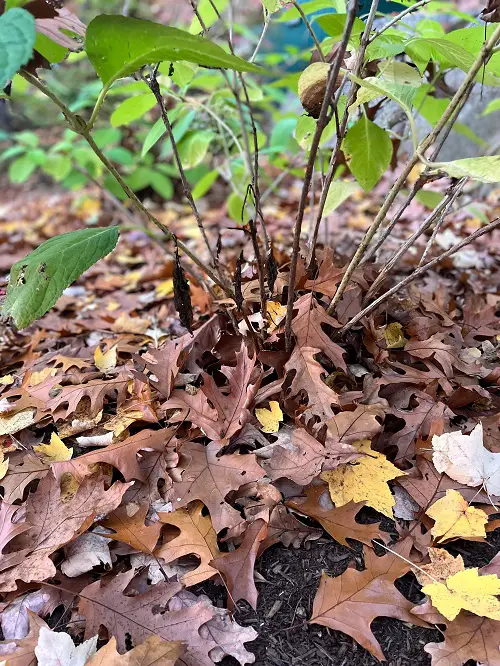Oak Leaf Mulching is an easy way to nourish and Turn Your Soil Into Pure Gold for your plants—and it’s fully natural and free of cost!

If your fall garden is covered with piles of crisp, auburn oak leaves, you’re in luck! Oak leaf mulching is a super easy, natural, chemical-free, and cost-free way of nourishing your soil. Also acidic, it’s like pure gold for vegetables, perennials, herbs, trees, and shrubs!
How Does Oak Leaf Mulching Help?
Oak leaves are slightly acidic; however, they do not drastically alter soil pH but may help boost acidity a bit over time. When the soil is not alkaline, your plants can better absorb essential minerals such as iron, manganese, and phosphorus.
This acidity comes from the presence of tannins in the leaves. The plant experiences seasonal changes and is pretty handy for enhancing the medium. Freshly fallen oak leaves are more acidic—pH of around 4.5 to 4.7—than fallen leaves that have begun decomposing, which is why old composted oak leaves won’t alter soil pH much.
So, depending on your soil and its needs, you can pick fresh or fallen, dried leaves for your mulch.
How to Mulch Your Plants with Oak Leaves?
It’s incredible how easy and effective mulching with oak leaves is—even a gardening newbie can do it! Simply sweep up fallen leaves around an oak tree in the fall, and that’s almost all there is to it. The best time to apply the mulch is in autumn.
This gives it time to decompose through winter and early spring, gradually enhancing the soil. It also helps protect and insulate your plants and the soil from frost. Spread a 2-3 inch layer of oak leaf mulch around the base of acid-loving plants.
Your potted plants will appreciate shredded oak leaf mulching as well, especially if you have planted blueberries, gardenias, ferns, lemongrass, and mint.
Shred the leaves using a lawn mower or by hand, but avoid piling them up too thick against the stems and base of the plants, as this can cause rot.
Pro Tip: Most oak tree varieties are great for mulching, but you should avoid black walnut trees as their leaves can add toxins to the soil. Our guide can help you pick the right oak varieties for mulch.
Benefits of Oak Leaf-Based Mulch

Flowering bushes like azaleas, camellias, and hydrangeas, as well as a host of veggies, herbs, and acid-loving plants, will thank you for this balanced nutrition, especially if your soil is not acidic. But that’s not all! Oak leaves break down slower due to their dense structure, which makes them last longer.
Apart from not having to replenish the layer too often, oak leaf mulch creates a habitat for beneficial organisms like earthworms—essential for healthy soil. These organisms break down organic material, improving soil fertility and aeration.
They also provide a habitat for animals like frogs, toads, slow worms, and hedgehogs. So you boost your medium’s health and provide a mini winter habitat for small wild creatures, transforming your garden into quite the biodiverse haven!



